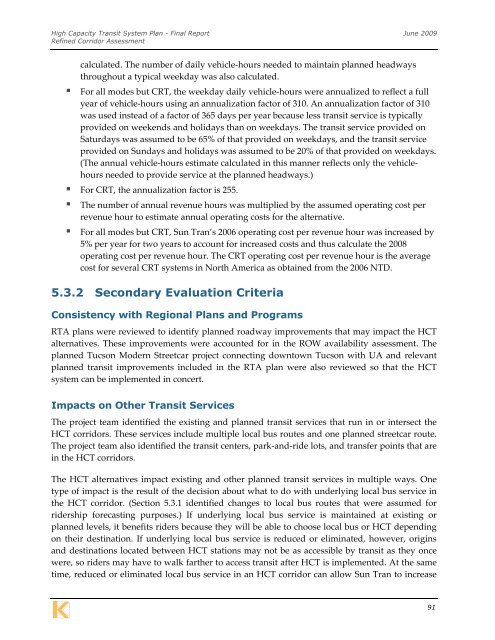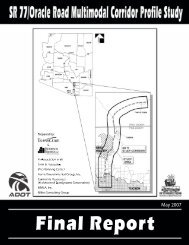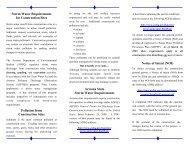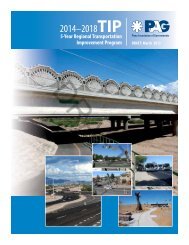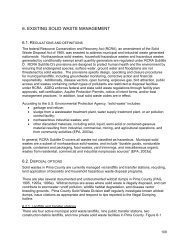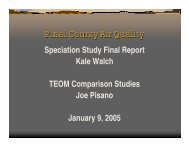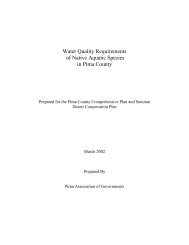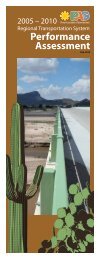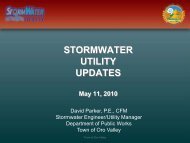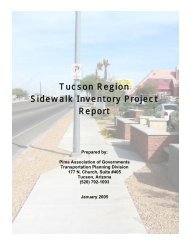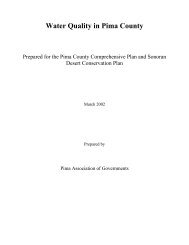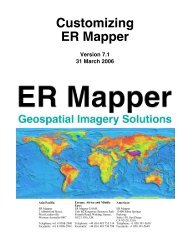Final Report - Pima Association of Governments
Final Report - Pima Association of Governments
Final Report - Pima Association of Governments
You also want an ePaper? Increase the reach of your titles
YUMPU automatically turns print PDFs into web optimized ePapers that Google loves.
High Capacity Transit System Plan - <strong>Final</strong> <strong>Report</strong> June 2009<br />
Refined Corridor Assessment<br />
calculated. The number <strong>of</strong> daily vehicle‐hours needed to maintain planned headways<br />
throughout a typical weekday was also calculated.<br />
• For all modes but CRT, the weekday daily vehicle‐hours were annualized to reflect a full<br />
year <strong>of</strong> vehicle‐hours using an annualization factor <strong>of</strong> 310. An annualization factor <strong>of</strong> 310<br />
was used instead <strong>of</strong> a factor <strong>of</strong> 365 days per year because less transit service is typically<br />
provided on weekends and holidays than on weekdays. The transit service provided on<br />
Saturdays was assumed to be 65% <strong>of</strong> that provided on weekdays, and the transit service<br />
provided on Sundays and holidays was assumed to be 20% <strong>of</strong> that provided on weekdays.<br />
(The annual vehicle‐hours estimate calculated in this manner reflects only the vehiclehours<br />
needed to provide service at the planned headways.)<br />
• For CRT, the annualization factor is 255.<br />
• The number <strong>of</strong> annual revenue hours was multiplied by the assumed operating cost per<br />
revenue hour to estimate annual operating costs for the alternative.<br />
• For all modes but CRT, Sun Tran’s 2006 operating cost per revenue hour was increased by<br />
5% per year for two years to account for increased costs and thus calculate the 2008<br />
operating cost per revenue hour. The CRT operating cost per revenue hour is the average<br />
cost for several CRT systems in North America as obtained from the 2006 NTD.<br />
5.3.2 Secondary Evaluation Criteria<br />
Consistency with Regional Plans and Programs<br />
RTA plans were reviewed to identify planned roadway improvements that may impact the HCT<br />
alternatives. These improvements were accounted for in the ROW availability assessment. The<br />
planned Tucson Modern Streetcar project connecting downtown Tucson with UA and relevant<br />
planned transit improvements included in the RTA plan were also reviewed so that the HCT<br />
system can be implemented in concert.<br />
Impacts on Other Transit Services<br />
The project team identified the existing and planned transit services that run in or intersect the<br />
HCT corridors. These services include multiple local bus routes and one planned streetcar route.<br />
The project team also identified the transit centers, park‐and‐ride lots, and transfer points that are<br />
in the HCT corridors.<br />
The HCT alternatives impact existing and other planned transit services in multiple ways. One<br />
type <strong>of</strong> impact is the result <strong>of</strong> the decision about what to do with underlying local bus service in<br />
the HCT corridor. (Section 5.3.1 identified changes to local bus routes that were assumed for<br />
ridership forecasting purposes.) If underlying local bus service is maintained at existing or<br />
planned levels, it benefits riders because they will be able to choose local bus or HCT depending<br />
on their destination. If underlying local bus service is reduced or eliminated, however, origins<br />
and destinations located between HCT stations may not be as accessible by transit as they once<br />
were, so riders may have to walk farther to access transit after HCT is implemented. At the same<br />
time, reduced or eliminated local bus service in an HCT corridor can allow Sun Tran to increase<br />
91


